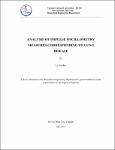| dc.description.abstract | BACKGROUND: The impulse oscillometry system (IOS) is widely used for accessing
oscillatory mechanics of the respiratory system. Oscillometric data, especially at frequencies around 5 Hz, provides useful clinical information which is sensitive to proximal and distal airways obstruction [2, 32, 33].
OBJECTIVES: The purpose of this study was to analyze impulse oscillometry parameters concerning their potential to determine the severity of disease in patients with asthma.
METHODS: Patients with asthma were randomized to attend lung function measurements of impulse oscillometry and spirometry from September 2010 to March
2012. A total 344 cases of asthma were divided into four groups depending on their stage
of asthma: 67 cases in intermittent, 91 cases in mild-persistent, 121 cases in moderate- persistent and 65 cases in severe-persistent. From all test results of impulse oscillometry and spirometry of the following terms were evaluated: R5, X5, R20, Z5, Fres and FEV1.
RESULTS: There is a significant change in the average values of impulse oscillometry parameters when compared within the stages of asthma. After splitting-up all asthmatic patients into 2 subsets: under 18 years of age and above, the baseline tracings of resistance and reactance in groups under 18 years allowed to discriminate four stages of asthma with increasing values of resistance and decreasing values of reactance in the entire range of frequencies from 5 – 35Hz, confirming the rise of severity in asthma. In addition, the IOS measures at low 5 Hz frequency correlated with forced expiratory volume (FEV1) in spirometry: R5 vs FEV1 ( r = -0,3 and -0.39), X5 vs FEV1 ( r = 0.33 and 0.62), Z5 vs FEV1 (r = -0.32 and -0.49).
CONCLUSION: IOS could be a reliable method to assess the degree of asthma especially
in children. The parameters R5, X5 and Z5 at 5 Hz frequency were comparable to FEV1. However, oscillometry and spirometry are complementary in a wide range of measurement results. Oscillometry allows us to derive specific respiratory information from normal spontaneous breathing of the subject [2, 32, 33].
Keywords: impulse oscillmetry, asthma, spirometry, lung function. | en_US |


